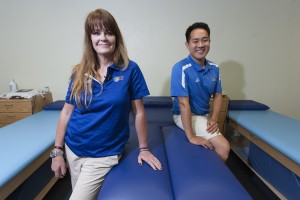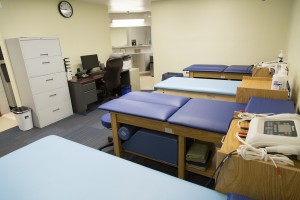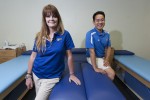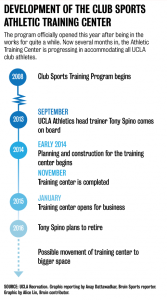
In his 37 years as a trainer for UCLA Athletics, Tony Spino had interacted sparingly with Club Sports.
So, when Executive Director of Recreation Mick Deluca sent him a message in 2013 asking to talk about a sports medicine program, Spino had no idea that a year later he’d be in charge of taking the program’s fledgling training center off the ground.
“This was a need that I didn’t even know existed. I was over (at NCAA training) for 38 years, and I didn’t even know (that there wasn’t a Club Sports program),” he said. “I thought these kids just got taken care of.”
When Spino joined in September of that year, the Club Sports Athletic Training Center was but an idea. UCLA Recreation had started a sports medicine training program five years earlier, hiring part-time sports trainers to work on athletes at Club Sports events. Their eventual goal was to expand the program into a more comprehensive one, centered around a training room that the 2,000-odd Club Sports athletes could go to for treatment on an ad-hoc basis. However, a lack of space had caused that goal to “stagnate,” said Chief Compliance Officer Jason Zeck.
The deadlock ended with the completion of Yates Gymnasium a few months before Spino came on board. The new gymnasium, located near the entrance of Wooden Center, includes a locker room for the women’s gymnastics team. That in turn opened up the team’s previous locker room – a small room located in a hallway between Pardee Gym and Collins Court. After some debate with the Recreation’s Facilities department, permission was granted to convert the locker room into a training center for club sports medicine.
At approximately 500 square feet, the room was a far cry from Spino’s much larger former workplace at Acosta Athletics Center. It was approximately half the size of the club sports training room at UC Santa Barbara – which Spino had visited when developing ideas for opening UCLA’s center in 2013. But it was a physical space, and that alone was a step in the right direction.
Jonathan Wu, a 2014 UCLA graduate, had worked with Tony Spino in 2012 as an intern for the UCLA Athletics Sports Medicine program. When Spino offered him the chance to work in the new facility after graduation, Wu accepted and became the second man in the center’s fight to take off the ground.
When Wu joined the center, the proposed space was still in the process of being converted from a locker room. Shower heads and lockers still adorned the walls, and a dividing segment split the room in two.
Rudy Figueroa, assistant director of student recreation venues, in charge of the construction from the Facilities side, faced quite the challenge. Both the limited budget – $50,000 for the entire project – and the characteristics of the room’s walls provided constraints to the Facilities team.

“There were water (pipes), load-bearing walls and a lot of other things we had to take into consideration (when tearing down walls),” Figueroa said. “We started almost playing Tetris after a point.”
After the space had been cleared, the ball moved into Brian Smith’s court. As the director of competitive sports, Smith worked with Spino to fill the space with equipment.
Operating on a $25,000 budget, Smith used measuring tape and handwritten calculations to solve the “jigsaw puzzle” of fitting the necessary equipment into the room.
By late 2014, construction in the room began to wind down and the center finally opened for operation. Over a year had passed since Spino joined UCLA Recreation and several months since Wu came on board. As 2015 arrived, the center went fully live. For Spino, the center’s opening was reminiscent of his start at UCLA Athletics.
“I remember how small we were when I started (at Athletics) – we had three trainers for all of men’s sports,” Spino said. “So, I know how to start small and build up. I think the biggest challenge was just going back and (telling myself), ‘It’s going to start small, it’s going to take a while to get big.’”
One of the initial hurdles the center faced was outreach. There are approximately 700 club sports athletes competing in impact sports, a list that includes lacrosse, rugby and ice hockey, among others. As a prerequisite for working with these athletes, the center needed a physical from each one of them – a first for many of the teams involved. The two-month-long task of informing and overseeing the completion of these physicals fell on Smith, who called it a “logistical nightmare.”
During that time, Spino and Wu, along with part-time athletic trainer Tracy Ayers, scrambled to deal with the various day-to-day challenges of running the center. The limited staff did everything from treating the 25-odd student-athletes who came by per day from inputting information into the database to outreach and other administrative work.
Difficulties forecasting first-year service levels and spending also hampered the center, Wu said. Unless they have severe injuries, athletes had to provide their own athletic tape as the center doesn’t have the funding to provide tape for all athletes. Furthermore, plumbing challenges meant the whirlpool tub has been non-operational to this date.
Despite these limitations, the center has provided a step-change in the level of service afforded to club athletes, Zeck said. Before its inception, Club Sports athletes had to go to the Arthur Ashe Student Health and Wellness Center or their primary care providers for ice packs, treatment advice or taping services. They can now have these services performed at the Training Center from 5 to 9 p.m. Club athletes no longer have to play through possible concussions – they can now get baseline testing and diagnosis at the center. Long waiting times to see doctors were once common for athletes with severe injuries. Because of Spino’s connections in the Ashe Center, athletes can now rapidly be seen by former Athletics physicians.
Spino is also working to start up a student internship program similar to the UCLA Athletics Sports Medicine internship, which Ayers said she hopes will provide an excellent opportunity for students to get hands-on experience.
“I think we provide a valuable service, and we want people to come here,” Ayers said. “We want people to come in and use the facility.”
As the end of the school year nears, the center has successfully made it off the ground. But challenges still loom ahead.
https://www.youtube.com/watch?v=CHJam6hyXNQ
Both Wu and Spino said they have seen the center begin to outgrow its space, but there are no clear plans for expansion in the near future. Staffing is also an issue, with both Ayers and Smith expressing their desire for a full-time trainer to provide comprehensive coverage. Finally, with Spino retiring in 2016, the center will have to find a new manager.
Despite these obstacles, optimism emanates from those involved with the center.
For Spino, the pleasure lies in his vision for the center’s future.
“It might be a slow, long process, as I’ve told the very first athletes,” he said. “This is something that will really benefit the kids who come after.”
Wu’s feelings toward the center are bittersweet, as he will be leaving to attend medical school next year.
“It feels great to be part of something that’s totally new, but very necessary for Club Sports,” he said. “These students are practicing every day, competing at the highest level for their sport. They deserve this.”

